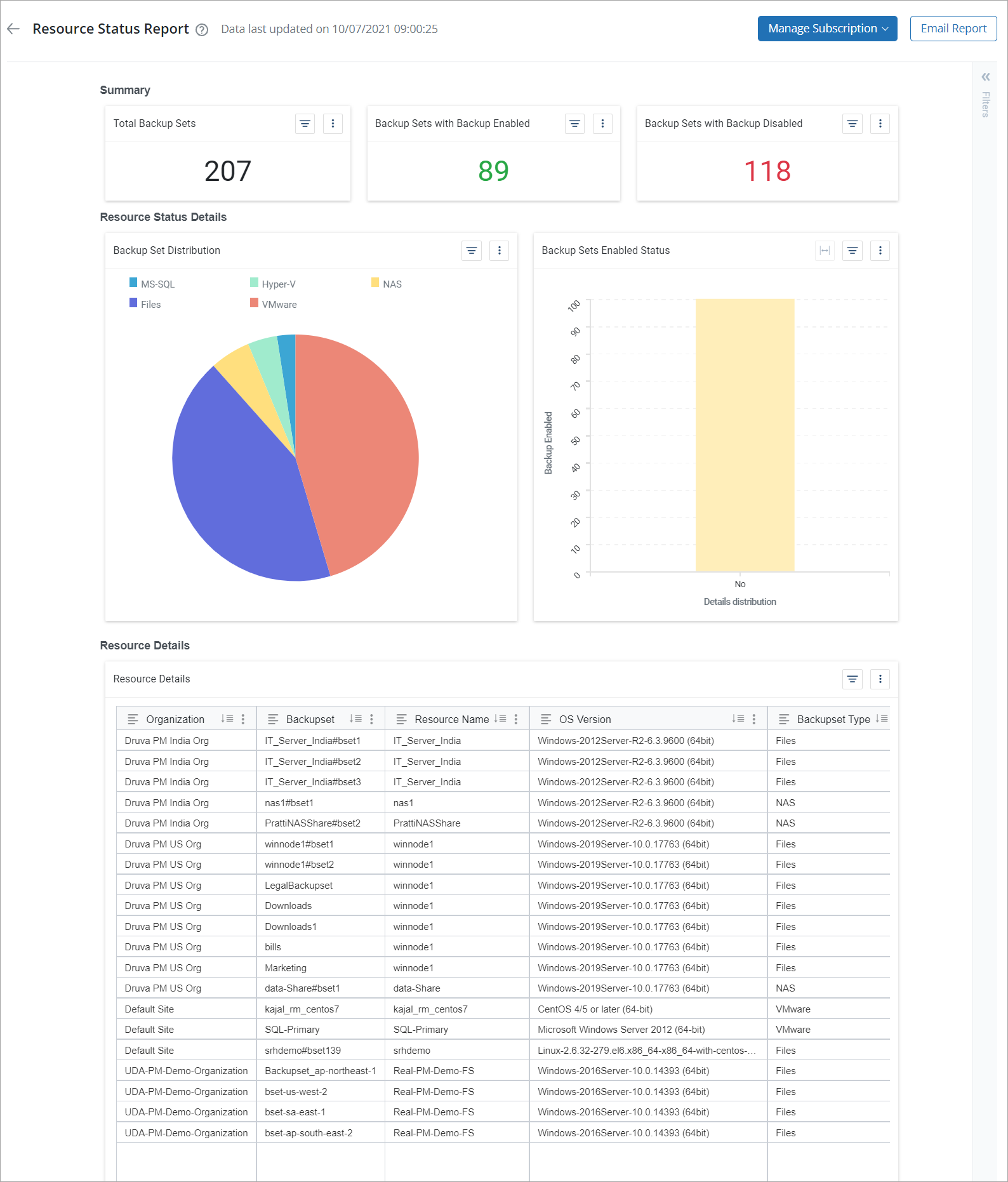Resource Status Report
Overview
Resource Status Report provides the status of all resources configured for backups with Druva. It gives insight into the resources’ details such as the operating system of the resource and the agent version. It further provides backup set details and whether the backup sets are enabled for backups. Based on the report details, you can perform an analysis of the count of the backup sets enabled and disabled for backups and take corrective actions.
Procedure
-
Log in to the Druva Cloud Platform Console.
-
Go to the Global Navigation Panel > Reports > Hybrid Workloads. The Hybrid Workloads Reports page appears.
Click Resource Status Report.The Resource Status Report page appears.
You can apply filters to the Resource Status Report to fetch resources’ details as per your requirements. You can view the generated report, download it, or send it through an email to the intended recipients. You can also download data in the widgets in the CSV and CSV-Summary formats. You can sort data in the Resource Status Details table using single or multiple columns, and rearrange the columns in the table as per your requirement.
Note: The report data is refreshed every two hours. The last updated time recorded for the report is displayed next to the report title. This timestamp follows the administrator’s time zone. However, the timestamps of the data fetched in the report follow the UTC time zone.
The following screenshot depicts a sample Resource Status Report.

The following screenshot depicts a sample Resource Status Report.
| Section | Field | Description |
| Summary | Total Backup Sets | The total backup sets created for the resources configured across all organizations. |
| Backup Sets with backup Disabled | The total number of backup sets that are disabled for backups. | |
| Backup Sets with backup Enabled | The total number of backup sets that are enabled for backups. | |
|
Resource Status Details |
Backup Set Distribution |
The pie chart depicts distribution of backup sets based on each workload. Hovering on the individual legends of the graph displays the count of the backup sets for that workload. |
|
Backup Sets Enabled Status |
The chart provides bifurcation of the backup sets enabled and disabled for backups. Hovering on the individual legends of the graph displays the count of the enabled and disabled backup sets. | |
| Resource Status Details | Organization | The name of the organization under which the workload is configured. |
| Backup Set | The name of the backup set associated with the resource. | |
| Resource Name | The name of the resource configured for backup with Druva. | |
| OS Version | The version of the operating system of the resource. | |
|
Client Version |
The version of the Hybrid Workloads agent installed on the resource. | |
| Backup Set Type | The type of the backup set created for the resource. For example, Files, VMware, and so on. | |
| Backup Enabled | The status of the backup set whether it is enabled for backup. | |
| Administrative Group | The name of the administrative group the workload is a part of. |
Actions
The following table lists the actions that you can perform on the Resource Status Report page.
| Action | Description |
| Add filter | Creates filters to display resource status data based on the filter’s selection. |
| Sort data | Sorts data in the Resource Activity Details table using one or more columns. |
| Rearrange columns | Changes the order of the columns in the Resource Activity Details table. |
Add Filter
You can apply filters to the Resource Status Report to fetch resource details as per your requirements. You can view the generated report, download it, or send it through an email to the intended recipients.
Procedure
- On the Resource Status Report page, click the filter icon.
The Filters widget appears with an option to add filters. You can define multiple filters based on your requirements. Druva fetches the report data based on the fields’ selection. - Click Add Filter.
- On the Filter dialog, select a field or type the field name in the Column box, and click Apply.
The Resource Status Report page now displays data specific to the filter created. Similarly, you can further create more filters and apply them to display resource details.
For example, to fetch data for resources belonging to a specific organization, select Organization from the filter options, select the Equals option from the Is drop-down list, and select the name of the organization. Click Apply.
The report now displays resource data specific to the Default Organization.
Sort data
Use the sort options to sort the report data in a single or multiple columns in an ascending or descending order.
Single-column Sort
Multiple-column Sort
The Apply Multiple-column Sort option allows you to sort report data using more than one column. The report data displays records based on the order of columns selected. For example, you may want to fetch resource data for specific backup set types deployed per organization. To sort data by the Organization and Backup Set Type columns, simply perform the following steps:
- In the Resource Activity table, go to the Organization column and click the More
icon > click Apply Multi-column Sort.
- Click the sort icon in the Backup Set Type column.
The Resource Activity table displays report data sorted based on the selected order of columns.
Rearrange columns
You can change the order of the columns in the Resource Activity table, Simply drag a column and drop it to the required position within the table.

